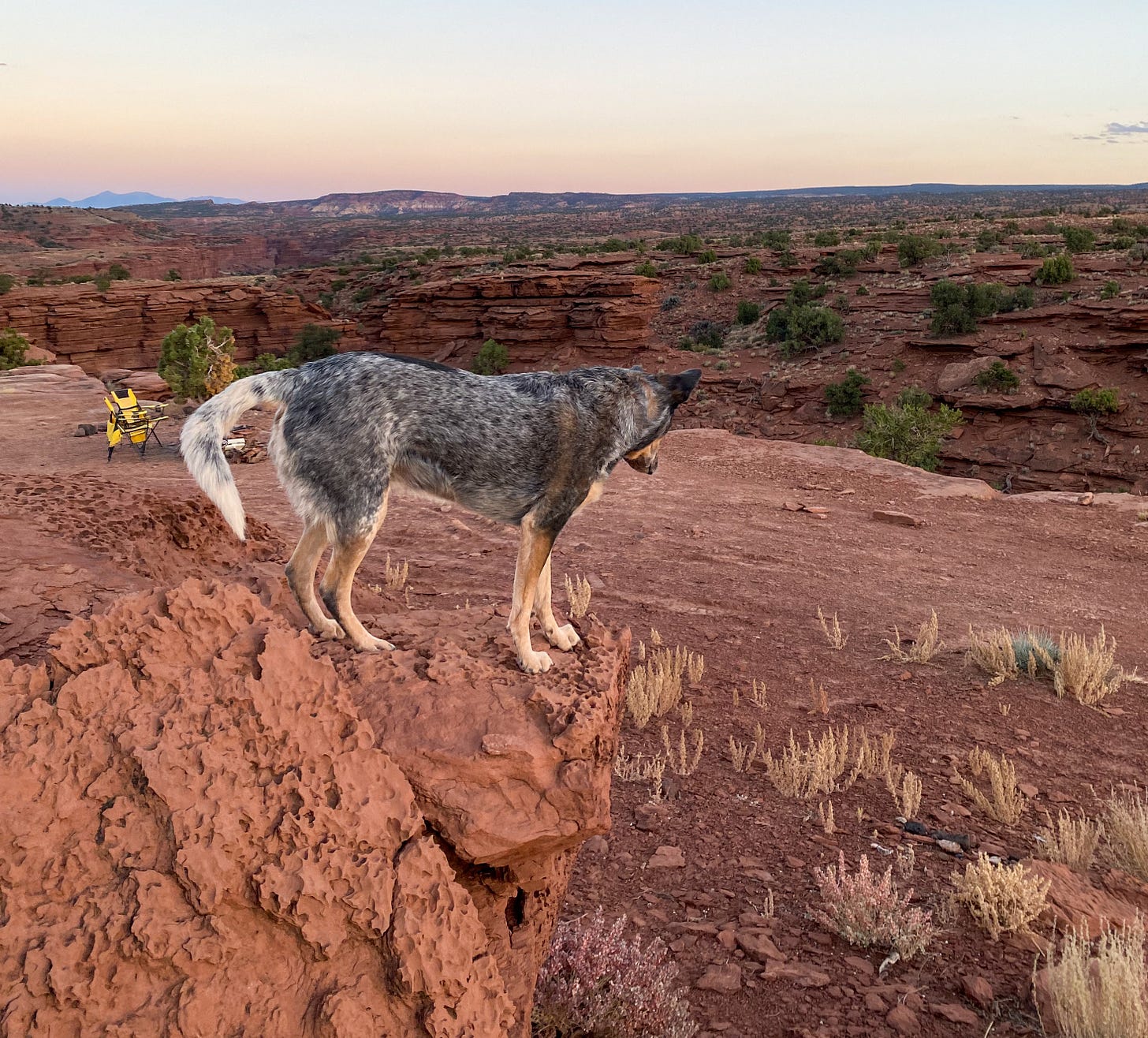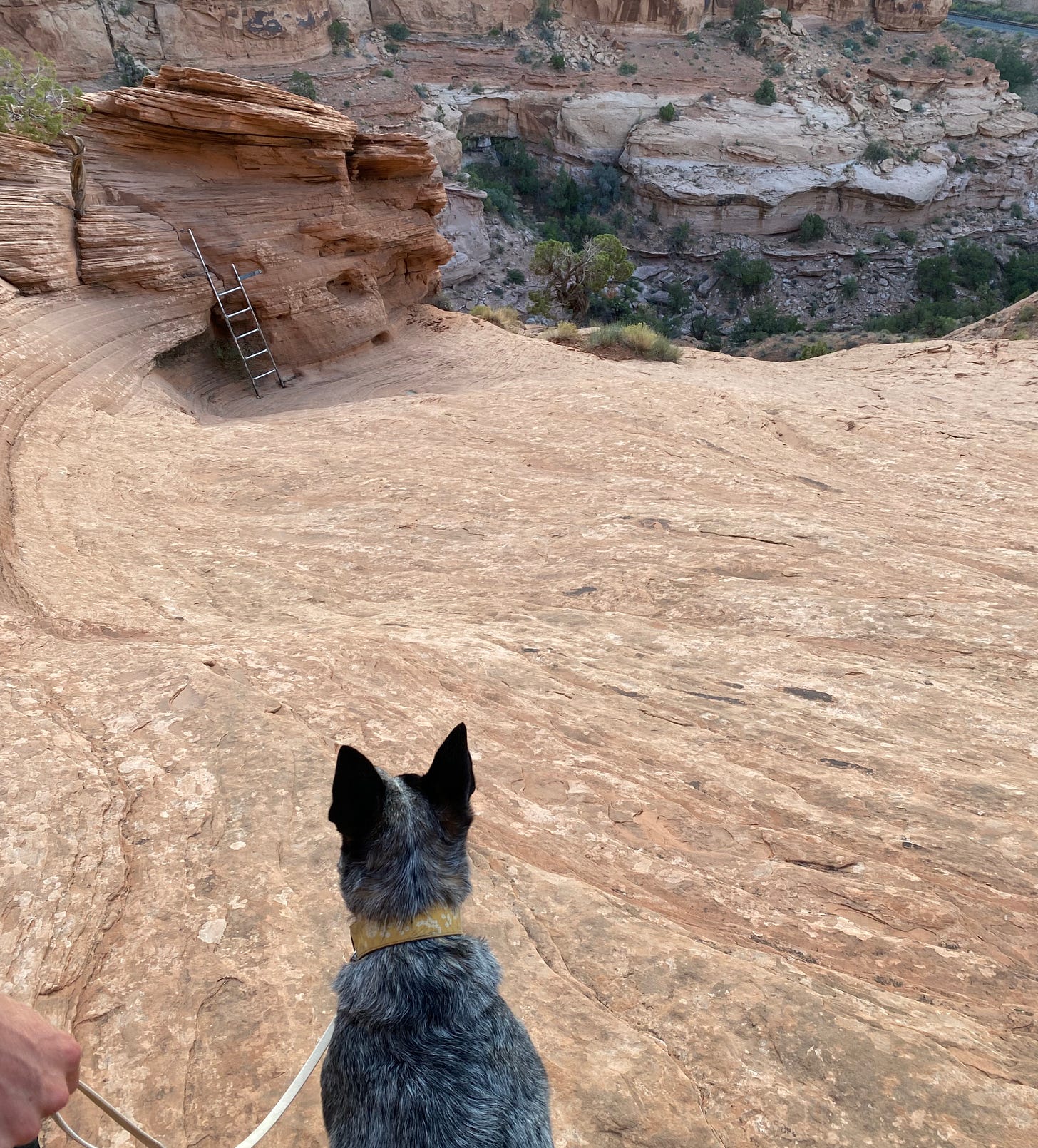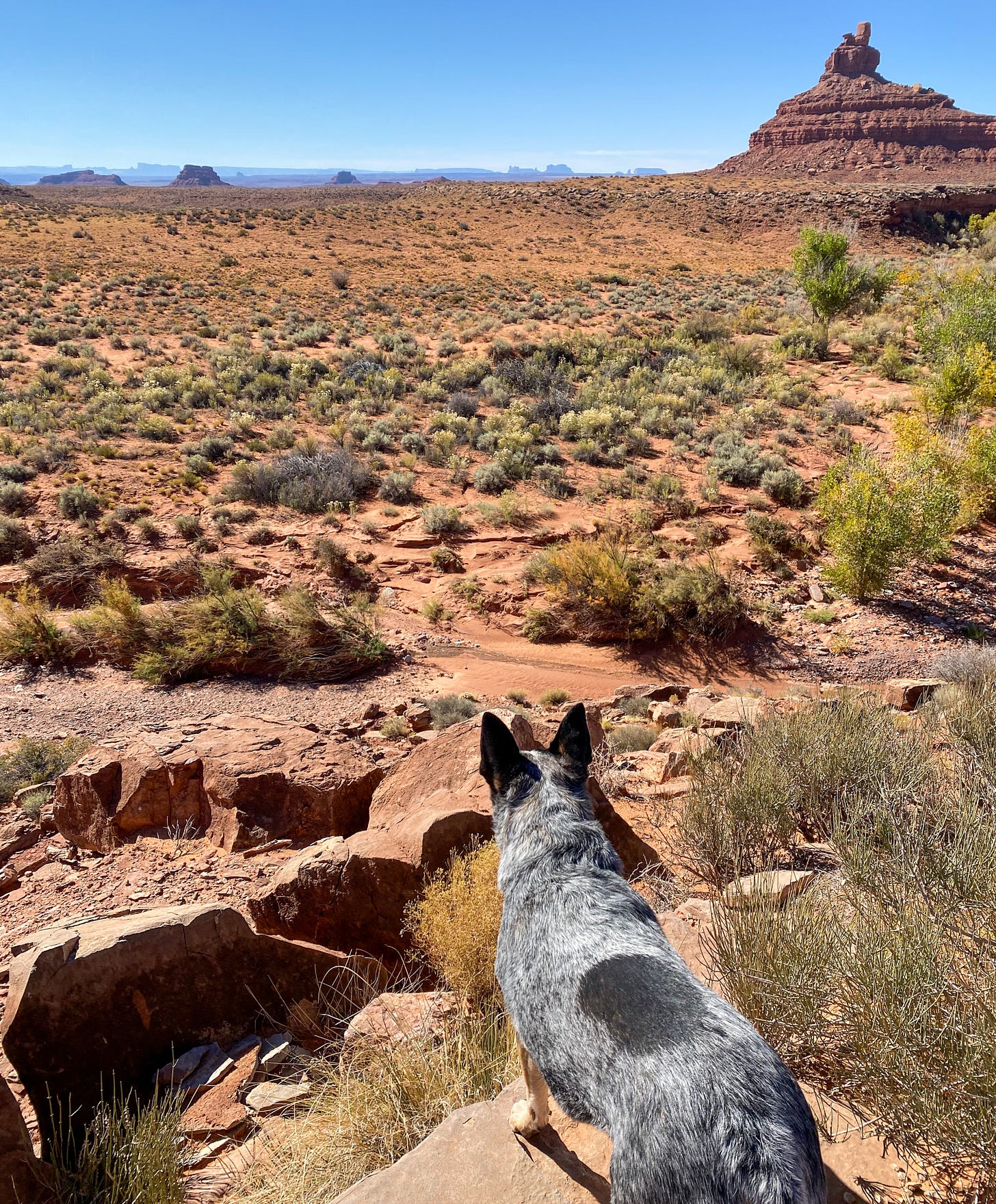My dog is a physical creature
Scout has arrived at her own version of the cattle dog’s stereotypical boldness.
Scout is joy incarnate leaping over rocks, clearing tree branches, launching herself after a favorite frisbee. Her tongue lolls. Her muscles ripple. Her tail sweeps air from left to right. She radiates satisfaction in these moments, the intrinsic kind—in the early days I lured her onto new surfaces with food, promised a reward for her effort, but those days are far behind us. Now she receives nothing more than her own endorphins and my fierce but intangible pride.
This morning we crept up the road from our camp, trudging through deep sand to overlook the desert landscape—our bright yellow rig a mere speck—from the crest. The distant buttes were still blue with low-angle light, the foreground’s goblin-esque rocks soft red. Scout sprinted ahead when we turned around (gait uneven as usual, not that it ever slows her down) and paused every so often to glance over her shoulder. Are you coming? She always seems to ask. Torn between a desire to go, explore, move—a yearning only evident in the last couple years—and attachment to her people.
We finished our excursion with a bit of amateur rock climbing, scaling the steep base of the structure shadowing our van. Last night, at a different nearby formation, my cattle dog tried to scramble up a nearly vertical face of dried mud. Thank god Sean was there to catch her. She’s steady on her feet, sure, but even her mountain-goat prowess is no match for such a sheer cliff (not to mention the even taller drop she could have fallen over on the other side).
It’s weird to worry about her self preservation. I’ve always felt she had too much. Scout was afraid of plastic bags blowing in the wind, tiny other dogs, waddling children, completely inert old couch cushions someone left on the side of the road for the dump. When I first adopted her she hesitated to place two paws on a chair. We spent weeks stacking pillows atop my apartment’s piano bench, repeatedly asking her to get on and off (our cue was “lava”, I felt so clever) until rote movement replaced hesitation.
Today, if anything, she goes too hard. It no longer feels remotely forced. It seems innate.
We hiked Corona Arch a few weeks ago, a moderate out-and-back trail with one tricky section of chains and ladders. I wasn’t sure at first how Scout would fare. I trusted she’d figure it out—I made sure to scroll photos before we decided to bring her—but was prepared to offer guidance. There was no need. She hauled herself up the tall rock face so quickly Sean had to drop the leash to avoid holding her back, throwing off her balance. At the top she stared down, tail fluttering, appearing to wonder what was taking so long as I made my own much slower ascent. Next was the ladder section. We veered to the side for a slightly-less-steep scramble sans the metal rungs, and it was the same story: In an instant Scout cleared the obstacle and stood waiting, patiently enough, for her humans to catch up.
I worried the way back would be harder. My dog and I agree going down is worse than going up, painfully averse to the sensation of the world slipping out from under our feet. So I backed down the steepest part first—clinging to the chain for full support—and threw wide my arms to catch her at the bottom. Sean released her to run to me.
Run to me she did.
When she landed against my body, head ducked as usual in perfect burrowing position, I couldn’t help but cheer. You’re so brave, I said. You’re so tough. My pride was magnified by the fellow hikers who’d watched her from the top, smiling as she conquered such tricky terrain with such little effort. Scout doesn’t understand words themselves, of course—but she understands my tone, my facial expressions. She absorbs the joy I am unable to hide the same way she never misses a millisecond of my anxiety.
My heeler does want to please me, at least to a degree. The way she catches my eye after clearing a particularly strenuous obstacle—open mouth, soft eyes, upright ears—sometimes seems boastful. She is a child on the playground making sure I saw her latest acrobatics. She is man’s best friend confirming approval.
But it’s so much more than that. Nowadays she springs around with no input from me or Sean. We couldn’t keep her still if we tried (barring strict down stays, something we rarely ask for anymore, because who would try to hold their once-reserved dog back?). She runs for the sheer sense of movement. Fast, she whispers to no one but herself. I am speed. I see clearly: She was meant to navigate the physical world.
Watching her like this, sometimes when she doesn’t even realize my eyes are upon her, makes me think of Jay Jack and Ivan Balabanov’s (and others I’m sure I’m forgetting to name) play-based training methods. How do we make our dogs’ hearts sing? What do they love to do? What makes them come alive? What inspires joy—pure, unadulterated joy—without external input?
Scout has arrived, fully, finally, at her own version of the cattle dog’s stereotypical boldness. It seems wrong to ever call her hard-headed, my sweet and gentle and easily overwhelmed friend, but her physical determination astounds me.
I love being able to grant her these opportunities to explore the world. To test new surfaces. To trust her body, to trust herself, and not merely because she trusts me. She is aging; she is often sore; she is still the sensitive soul I first met through the bars of a shelter kennel.
But she is also, undeniably, a badass.





